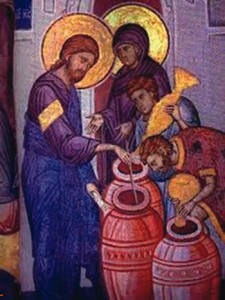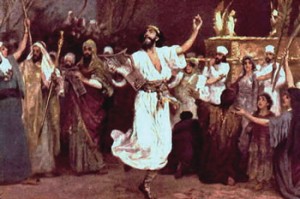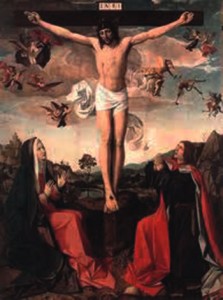Mary for Today – Woman for the Third Millennium (7)
Woman of Israel - Daughter of Zion
Introduction
The Litany of the Blessed Virgin Mary is a Marian litany originally approved in 1587 by Pope Sixtus V. It is also known as the Litany of Loreto, for its first-known place of origin, the Shrine of Our Lady of Loreto (Italy), where its usage was recorded as early as 1558. Much of what it said of Mary originates in the Older Testament. Mary can be perceived in the shadow of the persons and institutions of the OT. Abraham’s faith constitutes the beginning of the Old Covenant; Mary’s faith at the Annunciation inaugurates the New Covenant. (John Paul II Redemptoris Mater). The linking of both Covenants is found in Vatican II’s Dei Verbum – “God, who is the author of all the books of the OT and NT, in his wisdom and providence has brought it about that the New should be hidden in the Old and that the Old should be made clear in the New” (#16).
The Newer Testament texts we have portray Mary in Older Testament images; see how Luke takes the Canticle of Hannah (II Sam 2:1-14), mother of Samuel, to form Mary’s Magnificat (Luke 1:46-55). Luke takes the faith-filled personalities of the OT and the themes that reflect God’s work in Israel’s saving history, and weaves them into stories that show Mary as the fulfilment of these themes, images, and persons. The infancy narratives that begin Matthew and Luke use OT texts to interpret a new situation; the intention is not to explain the original text, but to make it relevant to a present set of circumstances. Luke’s intention is to explain the present (of Jesus, as well as of Mary) in the light of the past. Matthew parallels OT figures such as Moses and Rachel; sometimes quotations are used. Mary’s person and mission are read back into the OT, but also derived from it, and described by it.
Daughter of Zion
Mary is heiress to Israel’s faith at Sinai. When Moses returns from the mountain of God and calls the elders and people to covenant faith, they reply: Everything the Lord has said, we will do (Exod 19:8). This yes response is the heart of the OT’s message, and Moses is the mediator of God’s message that calls for the positive response that creates a new people of God. At Sinai Israel was born. Mary’s yes is seen both at the Annunciation (Lk 1:26-38) and at Cana (Jn 2:1-11). Gabriel is the mediator just as Moses was; Mary is hailed as the one found already graced or favoured by God. She enters into wise dialogue with Gabriel (Mary as Queen of Wisdom). Her yes is like that of her people Israel, bringing into being not only her Son but through him a new house of Israel, the Church.
In the Cana account the importance of the third day is stressed (Jn 2:1) just as it is in the Exodus covenant account. Moses warned the people: Be ready for the third day (Exod 19:15). Cana is about the new wine, symbol of the Good News of the time of the Messiah which comes about and results in Jesus’ disciples believing in him (Jn 2:11). A remarkable mutual recall of Sinai is seen in the Cana account in the Mother’s words to the servers: Do whatever he tells you (Jn 2:5). The people at Sinai answered together: Everything the Lord has said, we will do (Exod 19a). Israel is often presented to God as ‘spouse’ or ‘woman’, the latter term being used at Cana and Calvary for Mary.
Ark of the Covenant
In Luke, Mary is symbolised as the Ark of the New Covenant. The Ark marked the presence of God among the chosen people and contained the two tablets of the Ten Commandments. The Presence of God (the Shekinah) and the use of the over-shadowing cloud and fire to symbolise this presence are important for the revelation of God’s covenant with Israel (Exod 24:16; 40:34-35). The Annunciation parallels the Hebrew narrative as Mary becomes the living Ark of the Covenant, and the same verb (episkiazein) is used for ‘overshadowing’ the Ark and over-shadowing Mary: And the angel said to her in reply “The Holy Spirit will come upon you and the Most High will overshadow you. Therefore the child to be born will be called holy, the Son of God.” (Lk 1:35).
Then the cloud covered the meeting tent, and the glory of the Lord filled the Dwelling. Moses could not enter the meeting tent, because the cloud settled down upon it and the glory of the Lord filled the dwelling.( Exod 40:34-35.)
David’s dancing before the Ark may be compared with the Baptist’s leaping for joy within the womb of Elizabeth (II Sam 6:5; cf. Luke 1:41-44). Even the words of David and Elizabeth are equivalent in symbolism (‘ark of the Lord’ and ‘mother of my Lord’): David feared the Lord that day and said, ‘How can the ark of the Lord come to me?’ (II Sam 6:9). Elizabeth exclaimed: ‘And how does this happen to me that the mother of my Lord should come to me?’ (Luke 1:43).
In conclusion, the ark remains for a period of three months within the home of Obed-edom (II Sam 6:11), while Mary stays three months in the home of Elizabeth and Zechariah: Mary remained with her about three months and then returned to her home (Luke 1:56). Mary’s ‘yes’ accomplishes a new covenant with God. Jesus reposes in the new ark (Mary) and is God present among the people of a renewed Israel.
A Woman among the Women of the First Testament: Sarah joins Abraham in responding to the call to faith in the promises of God, as do Rebekah, woman of action, Miriam, prophet and sister of Moses, Rachel, whose great sorrow features in the Flight into Egypt, (Matthew 2:17-18), Ruth, Esther, and Judith as well as Tamar, Rahab, and Hannah and a host of unnamed women in the Scriptures. All of them play a vital role in liberation of the chosen people and as chosen mediators of God’s plan. In Ruth we see the Davidic lineage, his family origins, her enormous faith and trust. Esther is a woman of courage and prayer, interceding with both prayer and action at a moment of great peril. Judith, through the power of God, destroys the enemy of Israel. In reading the lives of these heroic women we find not only a call that echoes Mary’s call but the very language we use in praise of her.
The story of Judith is of a woman whose absolute trust in God places her among the anawim or poor ones, completely reliant on God. The blessing of Judith after her deliverance of her people from the dreaded might of Holofernes, general of King Nebuchadnezzar, contains many lines that are familiar to us and have been applied to Mary: Blessed are you, daughter, by the Most High God, above all women on earth (Jdt 13:18); You are the glory of Jerusalem, the surpassing joy of Israel; You are the splendid boast of our people (15:19); and finally from her own hymn: A new hymn I will sing to my God. O Lord, great are you and glorious, wonderful in power and unsurpassable. Let your every creature serve you; for you spoke, and they were made, you sent forth your spirit, and they were created; no one can resist your word. (Judith 16:13-14).
The Final Word
In the scene at the foot of the cross in John (19:25-27) Mary is seen in relationship to Eve who, side by side with the new Adam (Jesus), is in conflict with the serpent, and Mary becomes the mother of all the living as Eve had been. Raymond Brown in his commentary on John sees it as: the Johannine picture of Jesus’ mother becoming the mother of the Beloved Disciple seems to evoke the OT themes of Lady Zion’s giving birth to a new people in the messianic age, and of Eve and her offspring. The imagery flows into the imagery of the Church who brings forth children modelled after Jesus and the relationship of loving care that must bind the children to their mother.
Bibliography: Buby, Bertrand, Mary of Galilee v.2 Woman of Israel-Daughter of Zion New York: Alba House 1995.
Tambasco, Anthony J. What are they saying about Mary? New York: Paulist Press 1984.




 Entries(RSS)
Entries(RSS)